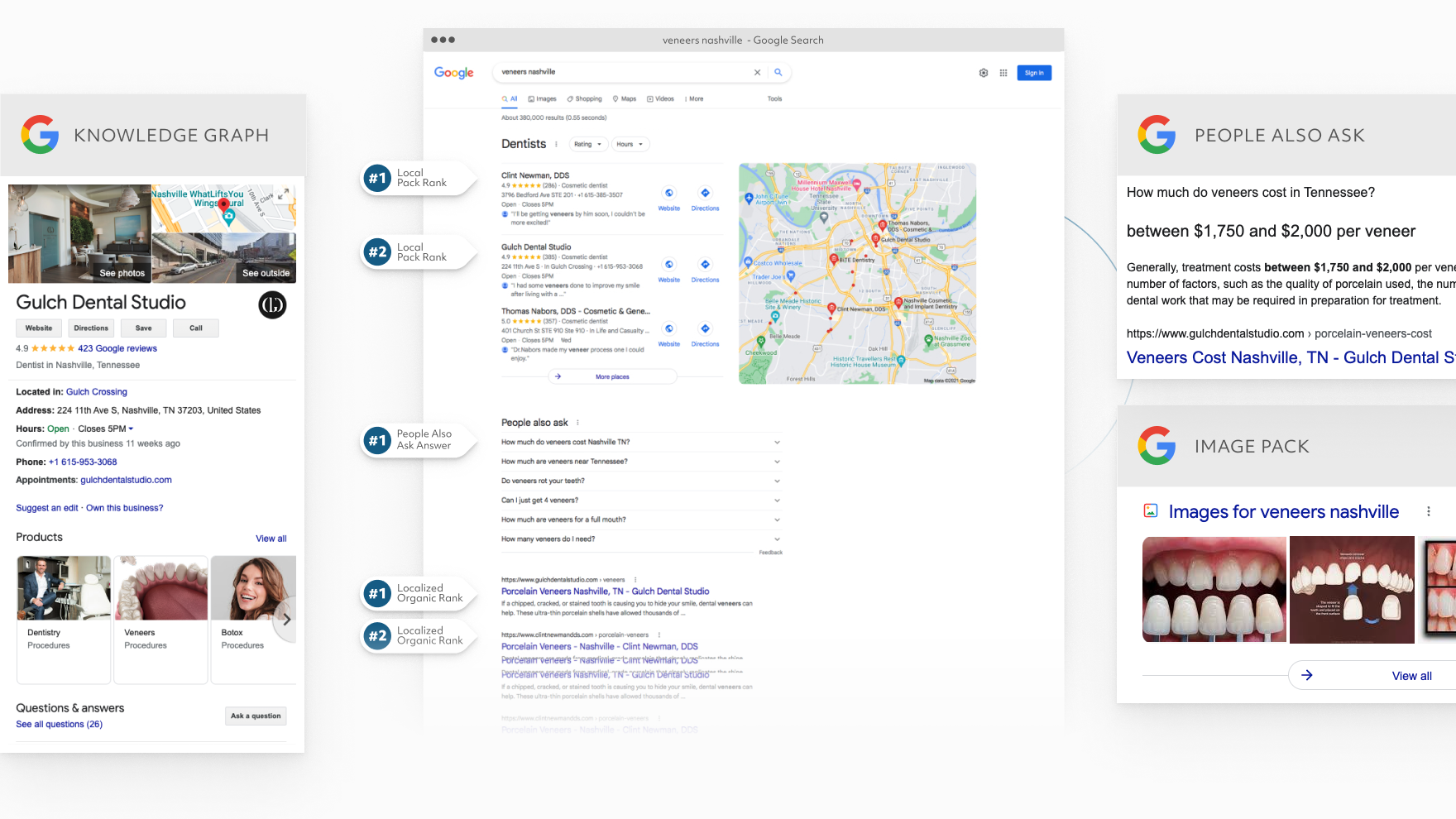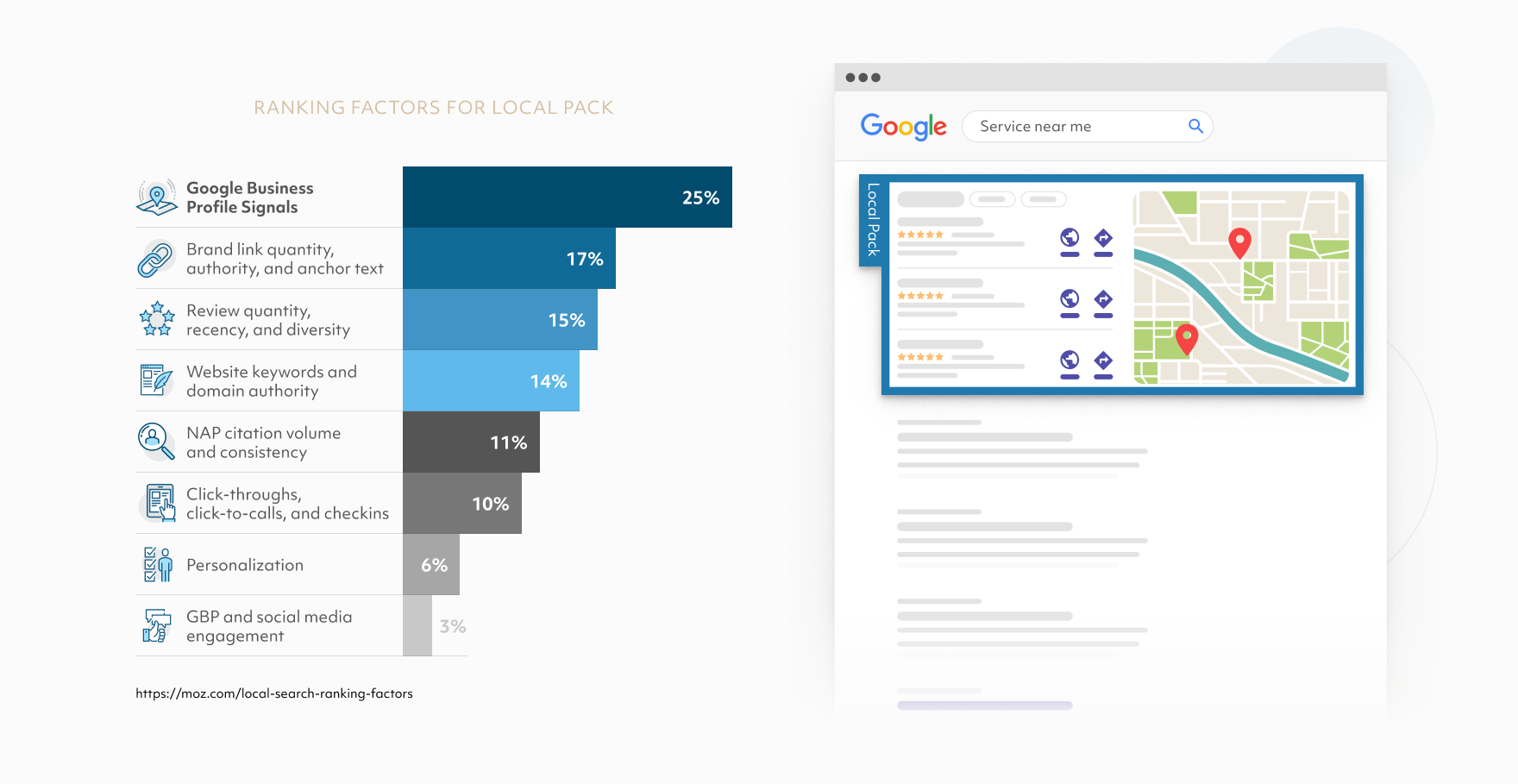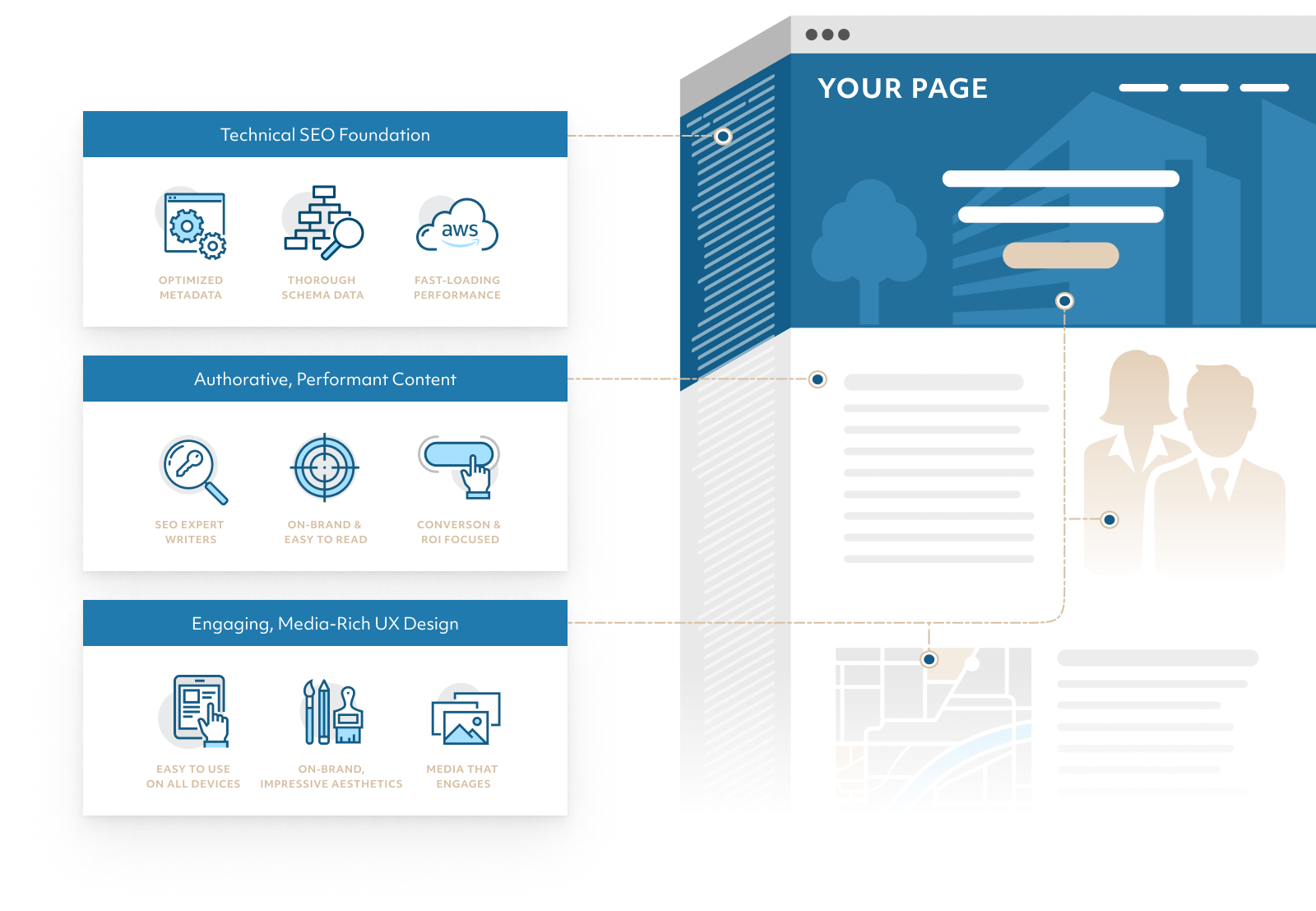The Comprehensive Guide to Dental Marketing in 2023

In order to keep your search rankings high and attract new patients, you’ll need to keep up with the ever-rising expectations of both Google and search users. To help, we’ve compiled a comprehensive guide to dental marketing that will cover all the major aspects of running a successful digital marketing campaign in 2023. Any dental practice that balances the factors listed below will greatly improve or maintain its search rankings and ROI.
Table of Contents
- Overview of Digital Marketing in 2023
- The Costly Myth of Online Dental Marketing
- Why Higher Levels of Investment in Online Marketing Are Worthwhile
- How to Know if You’re Getting the Most Out of Your Dental Marketing
- Dental Marketing 101: The State of Online Marketing in 2023
- Planning Ahead in the Ever-Changing SEO Market
- The Conflict Between AI and SEO
- High-Quality Content: The Core of Your Dental Marketing
- Helpful Content: The Building Blocks of All Dental Content
- Google’s Guidelines for Dental Content
- Different Types of SEO: Which Should I Prioritize in 2023?
- Organic vs Local SEO
- Blog Posts
- Content “Freshness”
- Social Media
- The Importance of Technical SEO
- Mobile-First Approach
- Deep SEO Integration
- Loading Speed and Performance
- Modern UX/UI
- First Impressions and Visual Appeal
- Flexibility and Expansion
- How to Know if You’re Getting the Most Out of Your Dental Marketing
- About Einstein Dental
The Costly Myth of Online Dental Marketing
Before we jump directly into the guide, we have to address a common myth about online marketing: that it’s an inexpensive or one-time investment. Unfortunately, the days of commissioning a cheap, static website for your dental practice are long gone.
Patients depend on the internet for information about your practice, and as far as they’re concerned, your online presence is a direct reflection of your business. They won’t stop to reconsider any first impressions of your brand when dozens of other results are two clicks away.
Your competitors know this, and they will do everything in their power to draw potential patients to their doors instead of yours. Competing practices won’t take their foot off the gas of their online campaigns because they understand that higher investments will yield exponentially greater returns as they attract more patients.
In other words, you cannot expect a great ROI from low-cost investments in your website and online campaigns.
Why High Levels of Investment in Online Marketing are Worthwhile
If you’re a business owner, you know that you can measure the value of your practice using a formula based on earnings before interest, taxes, depreciation, and amortization (EBITDA). Our clients have some of the highest EBITDA even with a higher marketing budget, and we’ve found that our happiest customers are the ones with the highest investments into online marketing.
Why? Because these clients earn much more revenue over time that easily makes up for the higher investments. In our experience, we suggest that you invest at least 8-10% of your gross revenue into your online marketing.
Many of our clients tried the “cheap, one-time investment” strategy in the past and did not get the results they wanted. They were caught in a cycle of short-term returns that never lasted long enough to generate a stable revenue worth the cost, and they kept switching internet marketing providers as a result.

Dental Marketing 101: The State of Online Marketing in 2023
In order to run a successful dental marketing campaign, we have to understand the general landscape of the internet. Google is not the only search engine around: there’s also Bing, Yahoo, Ask.com, etc., and each search engine uses its own set of algorithms to pull the most relevant results for a search.
But Google essentially owns a monopoly and controls over 90% of the search engine market in North America. Bing comes in second place at nearly 6% while every other search engine trails even further behind. We would love to see a more balanced playing field among search engines, but Google maintains a solid grip on the market. As a result, everyone who wants to see any decent ROI on their digital marketing campaigns must abide by Google’s rules.
Being subject to Google’s (sometimes questionable) decisions and regulations can be a challenge, but it does have some benefits: you won’t have to divide your attention by managing your brand on several search engines at once. We can narrow our focus to Google’s platform and not waste time learning the ins and outs of other search engines.
Planning Ahead in the Ever-Changing SEO Market
While details of the algorithm are a well-kept secret, we know that Google ranks search results based on hundreds of SEO factors. Google also updates its algorithms 12 times per day on average, and that number has likely gone up since Google released four massive overhauls in the past year alone.
Despite Google’s constant algorithm updates, we have found that one rule remains constant: content is king. To understand this universal rule, we have to look at how Google operates as a business.
Google’s main source of revenue comes from its advertising services. As we established earlier, businesses want to advertise on Google because it controls almost all search engine traffic. This means that Google’s revenue flow is dependent on its massive user base. If that user base ever started migrating to other platforms, Google would lose out on its major source of income.
As a result, Google has to keep its users (relatively) happy by providing the most relevant and useful search results possible. Google will always prioritize content that satisfies search users and maintains its user base in order to continue generating ad revenue.
The Conflict Between AI and SEO
Artificial intelligence isn’t new, but the recent surge in generative language AI like ChatGPT has sown chaos in multiple markets including SEO. These AI systems have reached new heights in the world of natural language processing (NLP), but they are still incapable of having true thoughts and insights.
Even if we disregard the ethical and legal issues surrounding AI-generated content, you’ll find that current AI like ChaptGPT is incapable of creating accurate and unique content that satisfies internet users. The creators of ChatGPT have admitted that their AI can generate and spread false information, and alternate NLP AI programs aren’t much better.
Despite these issues, many businesses were lured in by the idea of quick and easy content. The internet was flooded with AI-generated content, and Google responded by releasing several massive updates meant to limit (if not punish) the use of AI-generated content.
Unfortunately, these updates hit everyone’s rankings whether they provided high-quality, human-written content or not. Google has refined its counter-measures since then and continues to do so, but the standards for high-ranking content have rocketed skyward as a result.

High-Quality Content: The Core of Your Dental Marketing
Creating high-quality content that ranks well in Google searches is one of the core pillars of any modern dental marketing strategy. Great content will attract new visitors to your site, answer their questions, and generate more conversions for your practice. You can even think of each page on your site as an employee that works 24/7 and welcomes new patients to your brand.
Creating that level of content, especially in the competitive field of dentistry, is no simple task. You’ll need specialized knowledge in SEO, internet trends, writing, web design, and more to dominate your competition. There are hundreds of factors to consider, but here are some of the more basic and universal ideas that should be driving your content strategy.
Helpful Content: The Building Blocks of All Dental Content
“The helpful content system aims to better reward content where visitors feel they've had a satisfying experience, while content that doesn't meet a visitor's expectations won't perform as well.” - Google
To keep its user base relatively happy, Google introduced a series of content guidelines known as Helpful Content. Google defines Helpful Content as “helpful, reliable, people-first” content that provides a satisfying user experience. The Helpful Content guidelines contain a huge amount of information and details to unpack, but they address major issues such as:
- Content Authorship - The issue of authorship matters greatly for specialized fields like dentistry. When creating dental content, you should make your knowledge and authority in the field clear for both readers and Google.
- Page Experience - Page experience goes beyond the quality of content and asks if the user had a good or bad experience accessing the content. Good content might not matter if the user becomes frustrated with slow load times or excessive pop-ups.
- People-First Approach - Despite being a search engine company, Google wants content to be created for people first and search engines second. Bad practices such as keyword stuffing and clickbait headlines will drive users away and ultimately hurt Google’s bottom line.
These guidelines have existed for several years, and Google released a major update with the same name that punished certain “bad actors” Google defines Helpful Content as “people-first content” that provides relevant and accurate information to users. By comparison, “search-engine first” practices such as keyword stuffing will negatively impact your rankings.
Google’s Guidelines for Dental Content
Google established a strict set of guidelines for Your Money, Your Life (YMYL) content which covers “topics that could significantly impact the health, financial stability, or safety of people”. As you can guess, all forms of healthcare (including dentistry) fall under that category. Google judges YMYL content according to the experience, expertise, authoritativeness, and trustworthiness (EEAT) of a webpage and its authors.
- Experience - the first-hand experience of the content creator
- Expertise - the training or knowledge of the content creator
- Authoritativeness - the reliability of the creator or website as a source of information on the subject
- Trustworthiness - how accurate, honest, safe, and reliable the content or source is
Experience, expertise, and authoritativeness all contribute to a website’s overall levels of trustworthiness. Even with high levels of EEA, Google will rate content as “low quality” if there’s any reason to mistrust the source of information.
For example, the website of a well-known oral surgeon should check the boxes on experience, expertise, and authoritativeness. But if the site uses misleading links to try and manipulate the user into purchasing a service, Google will rate it as low or even poor quality.
Building trust in your brand is also one of the best ways to convert users into new patients, so maintaining an EEAT content library should be one of your top priorities.

Different Types of SEO: Which Should I Prioritize in 2023?
SEO is a broad term that covers several specialized forms of search engine optimization, but the goal of each type remains the same: to match search users with high-quality, relevant search results.
Without the proper use of SEO, Google will not understand your content well enough and your practice will not show up in relevant search results. The type of SEO that you should prioritize will vary depending on your business and your current SEO strategy. The three main types you should focus on in 2023 are:
- Organic SEO
- Local SEO
- Technical SEO
We’ll go into more detail about different technical SEO factors later in this guide. For now, we’ll look at organic and local SEO since those two subjects directly relate to the content on your site.
Organic Search Results and SEO
Organic search results refer to all search engine results that are not paid ads, and organic SEO is the process of improving your unpaid rankings on search engines like Google. Organic SEO can rely on hundreds of factors including the strength of your content, mobile optimization, and user experience. On a search engine results page (SERP), organic results often appear under paid-per-click ads and other SERP features like the local pack.
Organic results used to be the main focus of search engine results pages, but Google has been stuffing more and more ads into every SERP to get more of that sweet ad revenue. That said, the top three organic search results alone receive 54.4% of all clicks on SERPs, which suggests that users still trust organic search results more than paid ads.
Organic SEO should account for a huge portion of your dental marketing campaigns since it tends to bring in the most clicks, but there are some caveats. Building your organic ranking can take a lot of time, especially when Google can take several months or more to reevaluate the overall rank of a website. The top organic spots are also extremely competitive, and the click-through rate drops dramatically as you move past the top three results.
Even if you don’t want to enter a contest of pure organic SEO, you’ll need to improve it in order to build your reputation with Google and improve other ranking aspects of your site.
The Role of Local SEO
Local SEO is another form of SEO that helps match non-ad content to relevant searches, but local SEO also factors in the search user’s proximity. For example, if a user lives in Cincinnati and searches for “dentists near me”, Google does not want to show dental practices in Chicago even though some Chicago practices have better organic SEO.
A good local SEO strategy can help your business rank in the Local Pack, Google Maps, and other location-based searches. Local SEO promotes businesses with nearby brick-and-mortar locations, so you’ll see less competition from dental practices outside your local market. A lot of businesses tend to forget about local SEO or think of it as another factor of organic SEO, which opens up a lot of ranking opportunities for any competitors.
After Google’s local search update in 2021, local and organic SEO are more deeply intertwined with each other than ever before. You can make use of both to provide an exponential boost to your overall rankings and lead search users directly to your doors.
Other Factors to Consider for Dental Content
Is Blogging Still Relevant in 2023?
Yes, high-quality blogs are still a great tool to boost your SEO and attract more dental patients to your brand in 2023. However, the best practices of blogging have changed vastly over the past decade. Google cracked down on a lot of the negative practices that overtook blogging years ago, so keyword-ridden 300-500 word blogs won’t cut it anymore.
In 2023, blogs should only play a supporting role to high-quality landing pages and link back to those pages on your main site. They provide a great opportunity to hit long-tail keywords and cover more timely subjects that can’t be included in normal evergreen content.
Blogging in 2023 also provides a new way to improve your rankings: building your EEAT authorship for dental content. In December 2022, Google updated its EAT guidelines (expertise, authoritativeness, trustworthiness) to EEAT by adding “experience” to the mix. “Experience” refers to the first-hand experience of an author and essentially asks “Where did this information come from?” to help counter the flood of AI-generated content.
Blogging has always had strong ties with authorship, and so publishing blogs in 2023 under your name helps reinforce your status as a trained, experienced professional.
What is Content “Freshness” and Does It Matter?
Content “freshness” refers to how recently a piece of content was published or received significant updates. While the “freshness” of content (how recently the content was updated) is not a confirmed ranking factor, SEO experts agree that it can affect the rank of your content in certain contexts.
"When the query demands it, fresh content is a Google ranking factor." - SearchEngineJournal
Considering the strict standards for YMYL topics, we should assume that content freshness matters for dental content. Outdated or inaccurate content can misinform readers and impact your EEAT ratings, so you’ll need to keep your content updated with the latest best practices, studies, and statistics.
However, you shouldn’t go and constantly update your content. At best, you’ll waste a ton of time updating the schema and metadata of a page to make sure Google is aware of the changes. At worst, Google may flag your constant updates as suspicious activity. You may also go to update a page and realize that there’s very little to do since some information and practices hold up well over the years.
In order to get the most ROI out of your content, you’ll need to strike a balance between letting the content gain traction and updating it every so often. Finding that sweet spot can be a challenge, especially when you’re managing an entire website full of informative content. At Einstein Dental, we use our unique eiQ Recommendation Engine to automatically track hundreds of ranking factors and let us know when it’s time to update a page.
The Role of Social Media
Over the course of several years, some of Google’s top members have revealed that social media features its own organic rankings. While social media is not a major ranking factor for your site, it can influence your SEO standing by sharing your quality content and drawing more readers to your brand.
Google looks at customer engagement as a factor for ranking dental practices since more traffic and interactions suggest that users are interested in your brand. An active social media presence also signals that the information about your brand is up-to-date and accurate.
While you can target several different social media platforms, you should build your Google Business Profile (GBP) first. In the 2021 local SEO update, Google relaunched Google My Business as the new and improved Google Business profiles, a platform that combines aspects of local SEO and social media. You can post directly to your GBP and inform your patients of timely updates while also linking to your website and any other social media accounts.

The Importance of Technical SEO
Patients will assume that your website reflects your brand, so a slow or old-looking website will make patients think that your practice is outdated as well. The overall performance and appeal of your website is also a significant ranking factor for Google.
To keep up with the rising demands of both patients and Google, you’ll need to balance several factors of your site including:
- Mobile-First Approach
- SEO Integration
- Loading Speed and Performance
- User Experience/User Interface (UX/UI)
- Visual Appeal
- Choice of Media
- Flexibility and Expansion
Mobile-First Approach
While desktop browsing is certainly alive, it’s no longer the standard for websites. As of Q1 2023, over 58% of all global web traffic was accessed from mobile devices. Google saw a rapid increase in mobile traffic years ago and announced a complete shift to mobile-first indexing back in 2020.
Mobile-first indexing essentially means that Google will add the mobile version of your site to its database of search results and determine several ranking factors based on your site’s mobile performance. Google may still index the desktop version, but the mobile version will always weigh more when search engines rank a site.
As a result, mobile friendliness should be one of the top priorities when building a website because it will determine every other ranking factor of your site. At Einstein, we build dental websites from the ground up for mobile devices because it has such a huge impact on online visibility and performance.
Deep SEO Integration
Despite the complexity of Google’s algorithms and bots, the entire Google Search system is still just a bunch of computer code at its core. Even with modern AI and large language models, this code is not capable of understanding context or nuance. Google is terrible at understanding your brand without help, which means that you have to explicitly tell Google what your practice is and what services you offer.
Keywords will only take you so far, so we have to bridge the rest of the gap by using metadata and schema. You can think of metadata and schema as a machine-based language that communicates directly with Google. Metadata essentially lists the information about pages and your entire site in a way that’s understandable to Google. Schema, on the other hand, is like a table of contents or directory that helps Google locate and contextualize that information.
For example, you should list the name, address, and phone number of your practice in your site’s metadata so Google can feature it on SERPs. But Google will have trouble distinguishing that information from the vast amount of metadata attached to each page on your website. Schema guides Google to that metadata and says “Here is what you’re looking for”.
Both are necessary for Google to properly index your site and match your practice to search queries.
Loading Speed and Performance
The standards for page loading speed and performance are largely set by the advances in computer processors and internet speed. As these new advances become widely available, the baseline of acceptable loading times will constantly shift. Remember, new patients won’t stop to wait for your site to load when hundreds of other options are a click away, and Google will try to avoid promoting “slow” websites in order to avoid alienating its user base.
Unfortunately, improving your website’s loading speed is not always a straightforward process. Loading speed is actually an umbrella term that includes different methods of measuring page performance, and you can have wildly varying scores according to each method.
Luckily, Google clarified which loading speeds are the most important ranking factors in its Web Core Vitals guide. The three major loading speeds are:
- First Contentful Paint - the time it takes for the largest chunk of content to become visible, which is usually a high-definition image or video
- First Input Delay - the time it takes before the user can interact with the page, including scrolling down the page to see more content
- Cumulative Layout Shift - when the content’s position on a page stabilizes, or when you can start clicking on content without worrying that it will shift around at the last second
While Google may look at other types of loading speeds, these three factors will have the largest impact on your web rankings. You can see how individual pages perform with Google Lighthouse and other useful tools.

UX/UI and Accessibility
User experience and user interface (UX/UI) refer to the general layout, navigation, and emotional response that users experience on your website. A website with good UX/UI will be easy to navigate, easy to read, and direct users to the information that they’re looking for. Listing all of your services with links leading to a dedicated page for each treatment is a basic example.
Accessibility options also fall under this category, such as adding proper alt text for images and video transcripts. According to the ADA, over 97% of the top million homepages fail to deliver basic accessibility options, which can leave businesses vulnerable to website compliance lawsuits. That’s why we offer extensive ADA compliance options for our clients on top of our normal adherence to ADA guidelines.
First Impressions and Visual Appeal
Despite our best efforts, first impressions have a huge influence on what people think of others and your brand. According to Google, users can develop a first impression within 17 milliseconds of visiting a site based on what they see at the top of the page. And remember, with hundreds of other results a click away, search users have no reason to think twice about their initial impressions of your brand.
And like site performance, the standards for media are also constantly rising with tech developments like higher resolutions. Unfortunately, boosting the media and aesthetics of your site isn’t as easy as putting 8k photos onto every page. Higher resolutions mean longer load times, especially for users that own old or cheap devices. Potential patients will also forget about your brand if your site looks similar to other competitors, whether it's due to excessive stock photos or similar page layouts. The best way to distinguish your brand is by investing in professional-quality media and videos that are specific to your brand.
At Einstein, we’ve found that visually engaging images and headlines at the top of a page will do wonders for keeping potential patients interested in your practice. We also work with thousands of professional photographers and videographers to help set up photo ops and recording sessions.
Flexibility and Expansion
With all of the constant changes in the SEO industry and user expectations, a static website will not earn (or keep) the top spot in search results. You will need to frequently update or expand your website while minimizing downtime, and a great website won’t mean much if it goes offline for extended amounts of time whenever you need an upgrade.
That’s why your website needs to build on a robust yet flexible foundation. At Einstein Dental, we’re upgrading to a new web platform that’s built with those ideals in mind called Lucid 3.0. We’ll be able to add more juice to our clients’ websites at the touch of a button for easy expansion and implement new features that match online trends as they develop.
How to Know if You’re Getting the Most Out of Your Dental Marketing
Once you learn the pattern, it’s easy to spot a marketing strategy that’s not living up to its potential. Here are some of the common signs that you are wasting the potential ROI of your online campaigns:
- You’ve switched internet marketing providers three or more times in the past ten years
- You do not immediately know the amount of gross revenue you invest in online marketing
- You do not immediately know your quarterly or yearly ROI
- You do not know your cost per lead
- You’re not sure how your website stacks up against the competition
If any of these signs apply to your dental marketing campaign, then it might be time to rethink your strategy and switch to another web marketing provider. You can learn more about dental marketing by visiting our site or contacting us for a free, in-depth website and SEO audit.
About Einstein Dental
Einstein Dental has helped elite dental practices run successful online marketing campaigns and improve their ROI for decades. We understand that dental professionals like you have their hands full treating patients and running day-to-day operations, let alone keeping up with the break-neck speed of online trends and Google updates.
- 30+ years of experience
- Navigated multiple economic cycles
- Google Premier Partners
- Dental Service Organization
- Venture Capital Practice Acquisition


